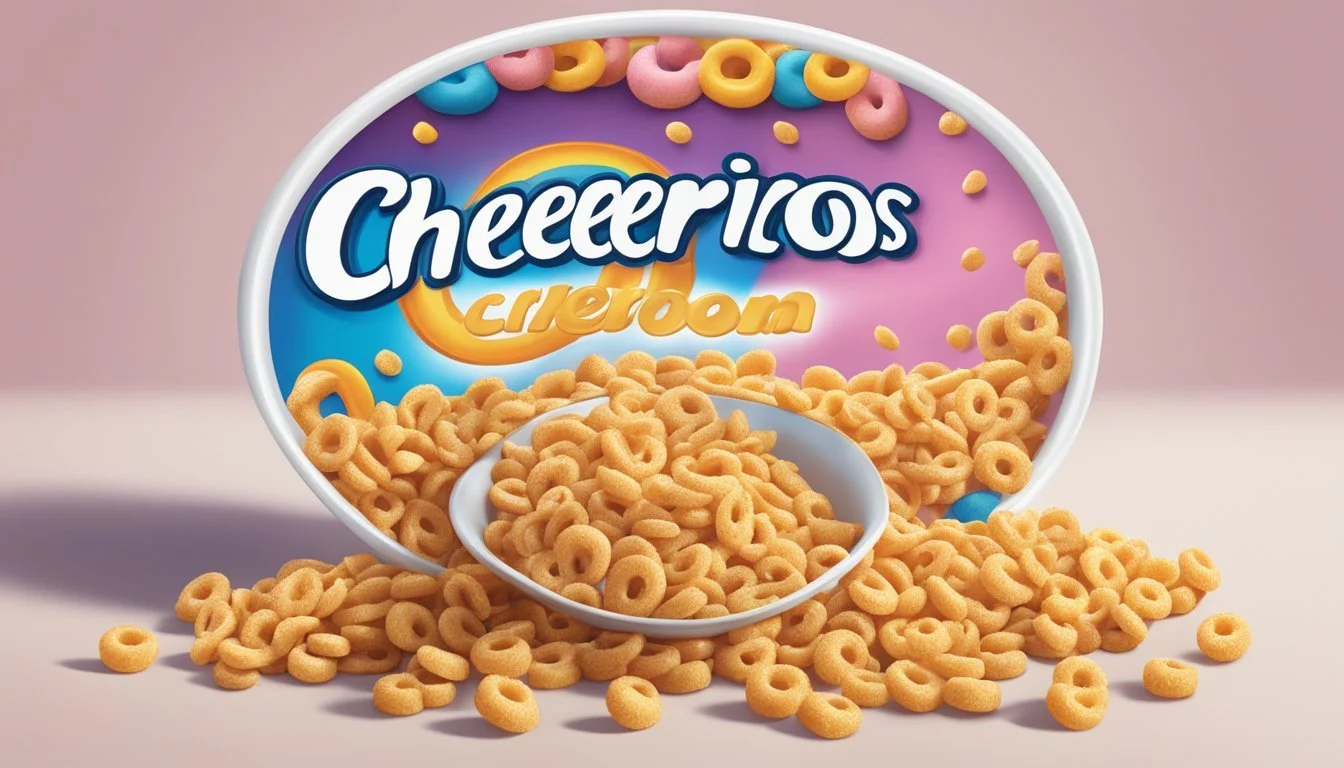Cheerios vs Kaboom
Comparing Nutritional Benefits
This Article is Part of Our Breakfast Cereal Guide with Details on Cheerios Nutrition and Kaboom Nutrition
When it comes to breakfast cereals, two names that often come up are Cheerios and Kaboom. While Cheerios are a staple in many households, known for their wholesome ingredients and heart-healthy benefits, Kaboom offers a different appeal with its colorful, fun shapes and sweet flavor. A head-to-head comparison of these two cereals reveals some interesting contrasts for any cereal enthusiast.
Cheerios, produced by General Mills, are famous for being low in sugar and high in whole grains, which makes them a preferred choice for health-conscious consumers. With a mild flavor and a satisfying crunch, they are often a go-to for both children and adults alike. Their simple ingredient list ensures that you start your day with a nutritious meal, contributing to better heart health.
Meanwhile, Kaboom, another General Mills creation, has a vibrant appearance and a flavor that appeals strongly to kids. This cereal is designed to be fun and engaging, featuring various colors and shapes that make breakfast an exciting experience. Although it has a higher sugar content compared to Cheerios, Kaboom delivers a burst of energy that can be ideal for those looking for a more indulgent start to their morning.
Historical Background
Cheerios and Kaboom, two distinctive breakfast cereals, have unique histories that highlight their impact and evolution in the market.
Origins of Cheerios
Cheerios, introduced by General Mills in 1941, originally went by the name CheeriOats. The cereal was developed by Lester Borchardt and his team using a specific puffing gun machine that shaped pulverized oats into small "O" shapes. This innovation provided a new way to present oats as a ready-to-eat breakfast cereal. By 1945, the name was changed to Cheerios, avoiding a conflict with a competitor.
Cheerios quickly gained popularity, partly due to its convenient and healthy oat-based composition. Over the decades, General Mills expanded the brand with various flavors and marketing strategies, securing a strong position in the breakfast cereals market.
Rise and Fall of Kaboom
Kaboom, another creation of General Mills, hit the shelves in 1969. This cereal was known for its colorful, clown-themed marketing and inclusion of marshmallow pieces. Aimed at children, Kaboom enjoyed initial success due to its sweet flavor and eye-catching appearance.
Despite this, Kaboom faced challenges over the years. Changing consumer preferences towards healthier breakfast options and stiff competition from other cereals led to a decline in its popularity. By the early 2010s, the product was discontinued.
Though Kaboom no longer exists, it remains a nostalgic memory for many who grew up during its peak years. The rise and fall of Kaboom reflect shifting trends in the breakfast cereals market and the impact of consumer health awareness.
Nutritional Comparison
This section compares the nutritional profiles of Cheerios and Kaboom cereals, focusing on their caloric content, sugar levels, fiber, whole grain content, and presence of essential vitamins and minerals.
Caloric Content and Sugar Levels
Cheerios contain 100 calories per 1-cup serving. They also have relatively low sugar content at 1 gram per serving. Kaboom, on the other hand, contains 103 calories per 1-cup serving but has a significantly higher sugar content, with 12 grams of sugar per serving. This makes Kaboom less favorable for those looking to minimize sugar intake.
Nutrient Cheerios Kaboom Calories 100 per 1 cup 103 per 1 cup Sugar 1 gram per serving 12 grams per serving
Fiber and Whole Grain Content
Cheerios are made primarily from whole grain oats and provide 3 grams of fiber per serving. This helps support digestive health. Kaboom does not emphasize whole grains in its ingredients and offers only 1 gram of fiber per serving, making it less beneficial in this regard.
Nutrient Cheerios Kaboom Whole Grains Yes (whole grain oats) No Fiber 3 grams per serving 1 gram per serving
Presence of Vitamins and Minerals
Cheerios are fortified with various vitamins and minerals, including Iron, Zinc, Vitamin C, and Vitamin D. They provide an adequate amount of these nutrients to support overall health. For instance, a serving of Cheerios typically offers 45% of the daily value for iron and 10% for Vitamin D. Kaboom is also fortified but with a higher content, providing 60% of the daily value for iron and 20% for Vitamin D. This makes Kaboom more nutrient-dense in terms of specific vitamins and minerals.
Nutrient Cheerios Kaboom Iron 45% daily value per serving 60% daily value per serving Zinc 25% daily value per serving 20% daily value per serving Vitamin C 10% daily value per serving 20% daily value per serving Vitamin D 10% daily value per serving 20% daily value per serving
Each product has its strengths, depending on individual nutritional needs and dietary preferences.
Taste and Flavor Profiles
Cheerios and Kaboom each bring unique taste experiences to the breakfast table. Cheerios offers a broad range of flavors, while Kaboom has a distinct, albeit less popular, taste.
The Variety of Cheerios Flavors
Cheerios comes in numerous flavors that cater to diverse palates. The original Cheerios has a light, toasty flavor with minimal sweetness. Honey Nut Cheerios are sweeter, with a pleasant combination of honey and nut undertones.
For those who prefer something different, there’s Chocolate Cheerios, which infuses a rich, cocoa flavor. Fruity Cheerios offer a burst of artificial fruit flavors, while Cinnamon Cheerios provide a warm, spicy kick.
Textures vary; some have a crunchier bite, such as the Oat Crunch Berry Cheerios. Others, like the Maple Cinnamon Roll Cheerios, are slightly softer. Each variety aims to balance flavor and texture to create a satisfying breakfast option.
Kaboom's Distinct Taste
Kaboom cereal, although discontinued, had a distinct taste that many remember. It was promoted as a healthier option but didn’t gain much popularity due to its taste.
The flavor was often described as artificial, with a mix of both sweet and slightly bitter notes. Some likened it to the taste of burnt carrots, which led to a divided reception.
Kaboom also included marshmallows, which added some sweetness, but the overall flavor was not well-received. Its texture was crunchy, but the aftertaste was often unpleasant, contributing to its eventual decline in the market.
Marketing and Brand Presence
Cheerios and Kaboom, both popular breakfast cereals, have developed distinct marketing strategies to capture their target markets and build strong brand identities. While Cheerios taps into health associations and family-centric values, Kaboom focuses on playful and nostalgic elements to resonate with consumers.
Cheerios' Marketing Strategies
Cheerios, produced by General Mills, has a robust marketing strategy leveraging health-focused messaging and strategic placement. The American Heart Association endorses Cheerios for heart health, a critical component of their branding.
By integrating influencer marketing, Cheerios reaches diverse demographics, utilizing both long-standing and modern advertising campaigns. An effective example is their emotionally uplifting advertisements featuring families and heartwarming narratives. Product placement in popular media also helps Cheerios stay relevant and connect with younger audiences.
Strategic discounts and promotions contribute to its presence on grocery shelves, cementing Cheerios as a staple in American households. The marketing strategy also continuously evolves, reflecting shifts in consumer preferences, like the growing demand for nutritious options.
Kaboom's Branding Efforts
Kaboom, known for its colorful cereal and playful mascot, focuses on nostalgia and entertainment. Unlike Cheerios, Kaboom appeals primarily to children and adults seeking a fun start to their day.
While less prominent than Cheerios in terms of health branding, Kaboom employs bright packaging and dynamic characters to attract attention. Marketers use retro advertising tactics, including vintage-style ads that evoke childhood memories, boosting its appeal among various age groups.
Despite a smaller market share, Kaboom maintains visibility through targeted social media campaigns and collaborations with pop culture influencers. Their branding highlights not just the product but the experience of joy and fun, establishing Kaboom as a beloved, albeit niche, breakfast choice.
Consumer Experience
When comparing Cheerios and Kaboom cereals, consumers have shared their experiences on taste and texture. With varied opinions and notable differences, each cereal offers a unique breakfast option.
Taste Test Reviews
Many consumers rate Cheerios highly for their balanced flavor. Cheerios' light sweetness appeals to a broad audience. Kaboom, on the other hand, has received mixed reviews. While some appreciate its fruity taste, others find it too artificial.
Consumer reviews highlight Cheerios' versatility; it can be eaten with milk or as a dry snack. Kaboom's recipe seems to target a younger audience, but some note that it lacks the flavor depth of other fruity cereals.
Taste Test Summary:
Cheerios: Lightly sweet, versatile.
Kaboom: Fruity, mixed reviews, artificial undertones.
Texture and Consistency Feedback
Cheerios are praised for their consistent crunch, whether eaten dry or in milk. This texture contributes to a satisfactory eating experience, retaining integrity even as they soak. Consumers appreciate the sturdy yet tender bite.
Kaboom also has a notable texture, with a crispiness appealing to kids. Yet, feedback suggests Kaboom may become mushy quicker than expected when combined with milk. Parents often mention Kaboom's bright, appealing colors, but some criticize the compromise on texture.
Texture Feedback Summary:
Cheerios: Consistent crunch, retains texture in milk.
Kaboom: Crispy initially, may become mushy in milk, vibrant colors.
Purchase Considerations
When choosing between Cheerios and Kaboom cereals, several factors come into play regarding their purchase. Key elements to consider include the cost of each cereal and their availability in the market.
Comparing Costs
Cost plays a significant role in deciding which breakfast cereal to buy. Typically, Cheerios can be found at a variety of price points depending on the retailer and package size. For example, a standard box of Cheerios may cost around $3 to $4. Kaboom cereals, being less common, might be priced slightly higher due to their rarity.
Retailers may offer discounts, especially for Cheerios, which is widely available. For instance, buying in bulk or during sales can reduce the overall price. In contrast, Kaboom, considered a niche product, often doesn’t benefit from such widespread sales promotions, impacting its cost-effectiveness.
Availability and Accessibility
Availability and accessibility are crucial for breakfast cereal buyers. Cheerios are widely distributed and can be found in most supermarkets, convenience stores, and even online retailers. This extensive availability ensures that consumers can easily purchase Cheerios regardless of their location.
On the other hand, Kaboom cereals are not as readily available. They might be found only in specialty stores or online. The limited distribution makes it harder for consumers to find Kaboom compared to the more ubiquitous Cheerios. This rarity might appeal to collectors or niche markets, but it poses a challenge for the average consumer looking for a convenient purchase.
Conclusion
Cheerios and Kaboom both serve as popular breakfast cereals, each catering to different preferences and nutritional needs.
Taste:
Cheerios offers a more subtle, oat-based flavor, making it a versatile choice for various toppings like fruits or nuts. Kaboom, on the other hand, is known for its vibrant colors and fruity taste, making it appealing to children.
Nutrients:
Cheerios:
Soluble fiber: 1g per 1.5-cup serving
Lower sugar content
Heart Health: Cheerios are often recommended for their potential to lower cholesterol due to their oat fiber content.
Kaboom:
Higher in sugar
Contains added vitamins and minerals for kids
Less fiber content compared to Cheerios
Breakfast Experience:
Cheerios are often seen as a healthier, everyday choice for adults seeking a balanced diet. Kaboom aims to make breakfast more fun and attractive for children, although it may not offer the same health benefits as Cheerios for long-term consumption.
In essence, Cheerios and Kaboom differ significantly in taste and nutritional benefits, catering to varied breakfast preferences.








